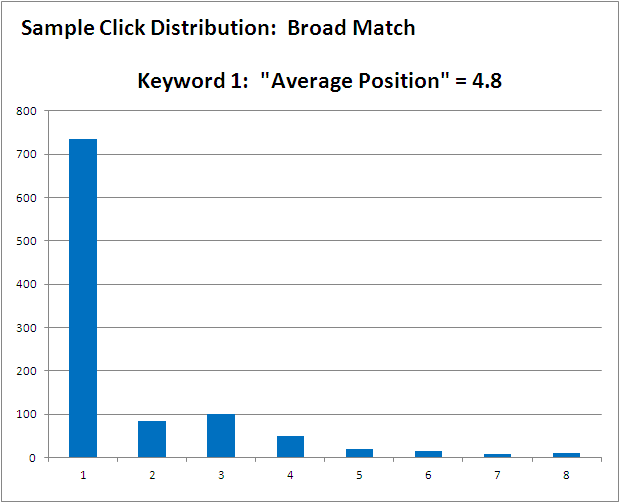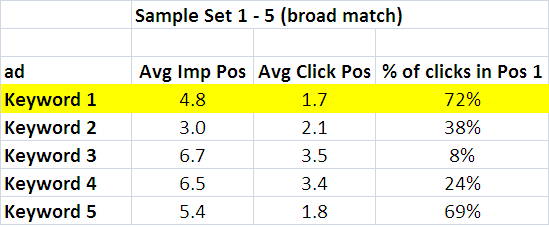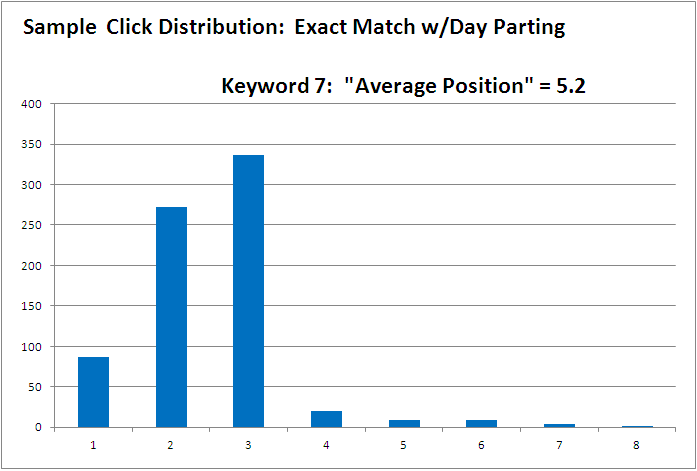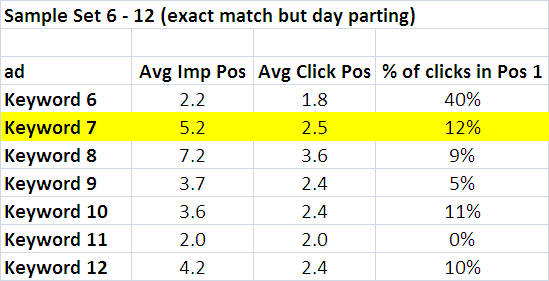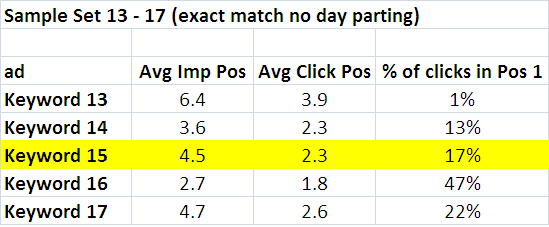Average Position: A Distracting Lie
A great many folks spend time thinking about position on pages, both for their ads and for their organic listings. People care about position, but it’s really a proxy for what we should pay attention to: traffic volume and quality. Indeed, position itself as a KPI is pretty meaningless, and focusing too much attention on […]
A great many folks spend time thinking about position on pages, both for their ads and for their organic listings. People care about position, but it’s really a proxy for what we should pay attention to: traffic volume and quality. Indeed, position itself as a KPI is pretty meaningless, and focusing too much attention on it can lead to mistakes.
Average Position Relates To Impressions, Not Clicks
Most of the traffic on a given ad comes when it is higher up on the page than its average position. That comes as a surprise to many.
Part of the disconnect is simple math. If the impressions are evenly spread by position, the clicks will skew higher on the page because the click-through rate at the top is higher than it is at the bottom.
Let’s take a look at a simple model to see how this works.
Above, you see an ad that has received 10,000 impressions in each position on the page. Because of the click-through rate differential, the average position of ads when clicked is higher than the average position of ads seen.
Now, this is just a model, and a person (Dora, the Paid Search Explora…) might argue “there’s no way my ads are being shown in all those positions!” This isn’t necessarily an invalid complaint — so let’s look at some real data for a single ad.
Dora says: “Holy mackerel! Its average position on my reports is 4.8, but more than 70% of the clicks on that ad happen when it’s in position 1!?!”
Let’s look at that ad (Keyword 1) and some of its cousins:
This is the norm, not an exception.
Dora says: “Aha! I know what it is! This is a broad matched ad, so it serves higher on some queries than others based on relevance, anticipated CTR, etc.”
Interesting hypothesis, Dora! Let’s then look at some exact match ads to see if we see a tighter distribution:
Dora: “It’s still all over the place! Surely this is an outlier!”
It doesn’t seem to be an outlier, Dora — and don’t call me Shirley!
Dora: “I bet it’s a product of day parting! We’re bidding more when the traffic is the most valuable, less when it is less valuable, so that’s what’s creating the huge distribution of positions!”
Could be! Let’s look at some exact match ads in a relatively new account for which we haven’t yet applied day parting algorithms:
Dora: “Okay, okay. So ads are served in a wide variety of positions even when they’re exact match and even when we’re not changing bid strategy intra-day. What gives?”
There are a number of factors:
- Personalization. Personalized SERPs mean past user behavior, location, device, etc., all play a role in what Google expects user behavior to be in paid search; thus, the rankings vary to best respond to anticipated user desire. The anticipated CTR for each ad varies based on the context of who, when and where the user is.
- Localization. Local competitors may displace your ads in urban areas, but not in others.
- Device targeting. Increasing bids for some devices over others can be a factor.
- Retargeting Lists for Search Ads. While still a small factor, bidding preferentially for users you know like your brand will create a wider distribution.
- Competitor behavior. Even if you’re not engaging in any of the above activities, if your competitors are, it will knock your ad around the auction.
- Mobile. You may be higher on the page for tablet and desktop than for smartphones or vice versa. In fact, screen size dictates that very few impressions exist for smartphone ads below the top placements.
Google likely does itself and the advertisers a favor by targeting the selection of ads not just to the query but to the context of the specific user. Serving more relevant ads to this person at this moment in this use case gets us all higher quality impressions and better focused traffic.
As KPIs go, average position clearly doesn’t tell you much about how your ad is served. A great deal depends on which auctions you qualify for and the competitive dynamics of those particular auctions. Indeed, the very fact that your ad isn’t served in every auction demonstrates the inadequacy of average position as a KPI. “My average position for this keyword is 3, so I have a lot of visibility there!” Maybe — but if you only qualify for 1/3 of the auctions, then your average position metric may not mean what you think it does.
It has always been problematic to set bids based on position — an issue I wrote about many years ago on SEL. Position-based bidding algorithms were the norm for the early (bad) bid platforms, but most platforms have evolved since then in favor of more sophisticated, ROI-driven algorithms.
What these data demonstrate quite clearly is that paying much attention to average position is a waste of time. What we need to study is the quantity and quality of the traffic driven as well as the factors that affect those much more meaningful numbers. Understanding the factors that influence an ad’s performance and bidding to the value of that traffic at that time assures efficient advertising. Trying to make decisions based on average position misses all the subtlety that goes into playing in an auction.
Does this same position myopia misguide SEOs? It certainly can and sometimes does, but that’s a subject for the SEO column!
Opinions expressed in this article are those of the guest author and not necessarily Search Engine Land. Staff authors are listed here.
Related stories

